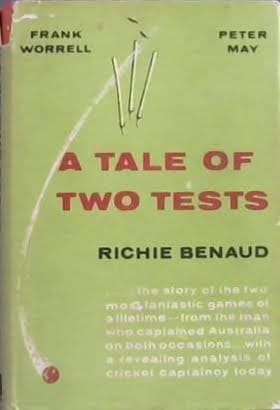 This is the title of the first cricket book I ever read. It is an account by Richie Benaud of two extraordinary Test matches in which he played a leading part both as player and as captain of Australia.
This is the title of the first cricket book I ever read. It is an account by Richie Benaud of two extraordinary Test matches in which he played a leading part both as player and as captain of Australia.
It is a very good book indeed – I have read it more than once since it was given to me not long after the matches were played. The first was the Tied Test between Australia and the West Indies at Brisbane in 1960-61. That game almost speaks for itself: Jack Fingleton wrote a book about it called The Greatest Test.
The second was the fourth Test between England and Australia at Old Trafford in 1961, a dramatic match with a number of enthralling turning-points, culminating in a brilliant spell of leg spin by Benaud which won the game for his side.
I thought of that title while following the two Test matches just recently concluded, between England and the West Indies at Headingley, and Bangladesh and Australia at Mirpur.
Both games illustrated what makes Test Cricket such a satisfying format. There was a delicious irony about this, as so many recent results have seemed to presage a dim future for five-day cricket, not least the previous encounter between England and the West Indies, in the day -night match at Edgbaston, when the visitors were utterly humiliated.
In the old days it is unlikely that Bangladesh would have remedied such a situation. Shakib also took five wickets in each Australian innings
Coming on top of the announcement that Ireland and Afghanistan had been admitted to the ranks of Test nations, the stage seemed to be set for the initiation of two-division Test cricket, with West Indies and Bangladesh, together with Sri Lanka and Zimbabwe, being shunted into the nether regions.
The result at Mirpur was not a complete surprise. Despite their creditable showing in India just a few months ago, Australia have long struggled in the sub-continent , and they seem genuinely uncertain as to what their best eleven is.
Once again it was the batting that let them down. David Warner made a determined and belligerent century in the doomed run chase but no one else made more than 43 in either innings. The fact that Steve Smith made scores of eight and 37 was almost enough to guarantee defeat.
Meanwhile Bangladesh, so long the whipping boys of Test cricket, have for a while now been steadily improving. Their early travails were not so much worse than those of other teams such as New Zealand; the sense of extended under-achievement was exaggerated by the increased amount of Test cricket being played.
It was a wonderful match. There were imperfections. There were a remarkable number of dropped catches. Both Braithwaite and Hope were dropped by Alastair Cook in the second innings and even Ben Stokes dropped a sitter near the end
There is nothing mysterious about the improvement. They have found a core of class players and stuck with them. The two outstanding ones are the exciting left-handed opener Tamim Iqbal, and Shakib-al -Hasan, one of the outstanding all-rounders in world cricket. Each of them played a crucial role in the victory at Mirpur, especially when they came together on the first morning after Pat Cummins had fired out three quick wickets.
In the old days it is unlikely that Bangladesh would have remedied such a situation. Shakib also took five wickets in each Australian innings.
They have an outstanding leader in Mushfiqur Rahim and new players are now coming through, like the off spinner Mehedy Hasan Miraz and the fast bowler Mustafizur Rahman.
No one can predict what will happen in sport but it seems plausible that Bangladesh will continue to improve. The difficult thing, when you start from such a low position , is actually learning how to win.
You find yourself in winning positions so rarely that when you are in one you just don’t know how to capitalise on it. But in the last few months they have beaten England at home and Sri Lanka away, as well as Australia. They will still struggle outside the sub-continent but they are beginning to look a useful unit.
For the West Indies, it was a bit different. Their performance at Edgbaston was so hopeless that no one gave them a chance at Headingley. There seemed to be a lack of depth and experience that made the series looks an embarrassing mismatch. After all, they lost nineteen wickets on the third day at Edgbaston.
They made only two changes for the second Test but one of them was absolutely crucial, the return of the fast bowler Shannon Gabriel. He gave the attack an energy and focus that were completely lacking in the first Test and England simply did not get enough runs in their first innings. That did not really become clear, though, until West Indies had completed their own first innings; after twenty one overs they were thirty five for three.
In fact there followed a quite extraordinary partnership between opener Kraigg Braithwaite and Shai Hope. They put on 246 for the fourth wicket and transformed if not the match then the way West Indies were perceived.
Braithwaite is the most experienced member of the top order: this was his sixth Test hundred. He doesn’t look pretty but he gets his head down and scores runs. The revelation was Hope. Aged twenty three, this was his twelfth Test. He had passed fifty only once in his first eleven, making ninety in the second innings against Pakistan at Bridgetown in April 2017, when no one else made more than 43 and Yasir Shah took seven wickets.
West Indies won the game. Hope really looked the part. The stand inspired captain Jason Holder and eccentric powerhouse Jermaine Blackwood to make useful and positive contributions and West Indies secured a substantial first innings lead.
England fought back hard in their second innings but when Johnny Bairstow departed on 327 for seven they were still only 158 ahead. West Indies should have established control of the game then but this is the point about not being used to attaining winning positions. Holder seemed at something of a loss and Moeen Ali launched a sublimely silky assault.
All the bowlers suffered, Gabriel included, and England ended up with nearly five hundred. Heads dropped. The openers survived the closing overs but most pundits expected an early finish on the fifth day with James Anderson celebrating his five hundredth Test wicket. No one seemed to think West Indies had a serious chance of reaching the target of 322.
Instead, there was another steadfast and resourceful partnership between Braithwaite and Hope, 144 this time. Braithwaite fell for 93. At tea they were 199 for three and Joe Root took the new ball.
This was one of a number of pivotal moments in the match: how, at this crucial stage, with a rare away victory so tantalisingly close, was Hope going to shape up to the most experienced and probably best new ball attack in world cricket?
He was magnificent. Hope was remarkably cool, given his relative lack of experience and his modest record before this game. He became totally becalmed in the 70s and seemed unable to break the shackles.
One thought something was bound to snap. But it didn’t. He knuckled down, and, with his decisive footwork and crisp stroke play he put some observers in mind of Root: high praise indeed.
He lost Roston Chase to an amazing catch by substitute Mason Crane of Chris Woakes, but this brought in Blackwood who upped the tempo in typically frenetic style. Hope reached his second hundred in the match – the first man ever to do this in first-class cricket at Headingley – yes , not Herbert Sutcliffe, not Len Hutton, not Geoffrey Boycott , but Shai Hope. And then he hit the winning runs.
It was a wonderful match. There were imperfections. There were a remarkable number of dropped catches. Both Braithwaite and Hope were dropped by Alastair Cook in the second innings and even Ben Stokes dropped a sitter near the end.
And Gabriel bowled too many no-balls that were not called. But as a contest the game had everything.
Does it mean that West Indies are now a better Test match team? Probably not: one would still expect England to win the final Test at Lord’s. But in Shai Hope they might just have unearthed their next great player.
Bill Ricquier, 02/09/2017
This article was featured in ScoreLine Asia: https://scoreline.asia/a-tale-of-two-tests/




